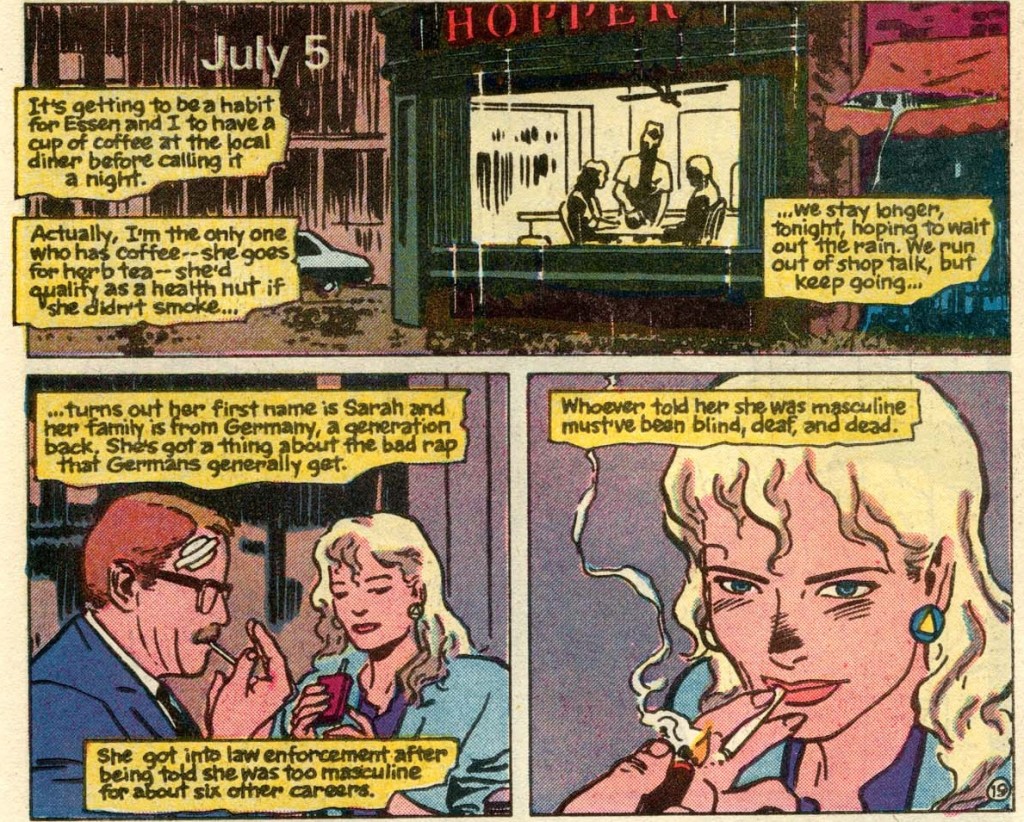 Batman #406
Batman #406
When people talk about the tendency for bestowing gruesome violence against prominent female characters in comic books – the ‘women-in-refrigerator’ trope – Sarah Essen is always one of the first names to come to my mind. She was a genuinely engaging character in the world of Batman comics for about a decade, playing a key role in the life of James Gordon in particular and Gotham City as a whole. She kicked ass and helped save the day more than once, even as she remained resolutely on the civilian side of the cast (i.e. no goofy costume or codename for her). And she sure deserved a much better fate than what she got.
Then again, at least Sarah Essen came a very long away, given that she essentially started as a vague line in Frank Miller’s 1986 opus The Dark Knight Returns. In that futuristic tale, Commissioner James Gordon mentioned that he now lived with a vegetarian woman named Sarah. The need to protect her served as inspiration every time he had to act tough and stand up against criminals, with Jim repeating the mantra ‘I think of Sarah. The rest is easy.’ throughout the acclaimed mini-series.
When Miller rebooted Batman’s continuity the following year, he decided to retroactively establish Sarah – or, at least, *a* Sarah – as part of the Dark Knight’s saga from the start. Batman: Year One introduced Sarah Essen as a police detective who worked closely with James Gordon (a lieutenant at the time) on the first investigation into the bat-clad vigilante who had recently begun assaulting crooks and cops on the take.
Sgt. Essen actually got quite a bit of characterization – especially compared to Bruce’s mystery date. She came across as a Hawksian blonde (David Mazzucchelli’s art gave her hints of Lauren Bacall) who did more than just light up Jim’s cigarettes in a sexy way (although she did that as well). Sarah was the first to suggest that Bruce Wayne should be a prime suspect and, at one point, she even briefly got the drop on the Caped Crusader:
 Batman #405
Batman #405
Keeping with the story’s mature, gritty tone, Sarah had an affair with Jim, whose wife was expecting a baby at the time. When he broke it off, Sarah requested a transfer and left Gotham City. Refreshingly, these were two grown-ups dealing with a complicated situation in a grounded way. Although the result wasn’t as powerful as, say, the third episode of Horace and Pete, the whole thing was handled beautifully, with a level of subtlety and restraint rarely seen in Miller’s other comics. In fact, this subplot was so neatly resolved that you could almost imagine Sarah not showing up again…
In late 1990, though, Sarah Essen came back in style (and with red hair, for some reason). By then, Batman comics were still clinging to the notion that The Dark Knight Returns was a possible future, so – after having introduced a tank-like Batmobile in The Cult and having killed off Jason Todd in A Death in the Family – it made sense to set up the forthcoming relationship between Sarah and Commissioner James Gordon.
In ‘Night Monsters’ (Batman #458), Sarah was transferred back from New York to Gotham, where she came to head the Major Crimes division. She hadn’t lost any of her edge – as soon as she stepped off the train, she immediately arrested a mugger while Jim blacked out:
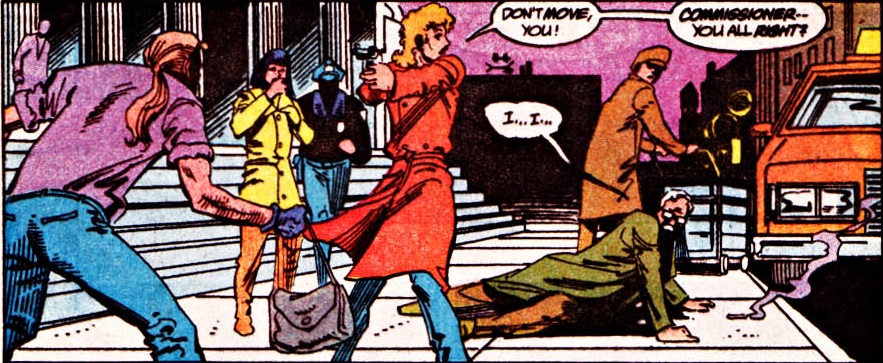 Batman #458
Batman #458
(This panel is not the only cool nod to Batman: Year One. The amazing duo of Alan Grant and Norm Breyfogle squeezed in a number of other callbacks, including a scene at an Edward Hopper-inspired diner like the one featured in the beginning of this post.)
It’s nice that the creative teams in the Bat-books took their time with the romance between Jim and Sarah. They were both widows by then and it was obviously a matter of time before they got engaged, but we still got to see them smoothly getting closer again. One of the high points was ‘Saturday Night at the Movies’ (Batman #459), in which they went on a date that, needless to say, was interrupted by police sirens (because Gotham). The issue cleverly used film tastes to make a point about different characters, including these two cops, who refused to watch horror, exploitative pulp, or TMNT-style shlock, choosing instead to attend a screening of the original The Mark of Zorro, which mirrored their ideals of old-fashioned romantic heroism (and, in a way, their connection to the Caped Crusader).
Not that there were no disagreements between the two lovers. Sarah Essen – who once again came close to figuring out Batman’s secret identity, in Detective Comics #641 – didn’t like the Dark Knight’s brand of vigilantism. She tolerated it, because Jim respected Batman so much, but this was a recurring source of tension:
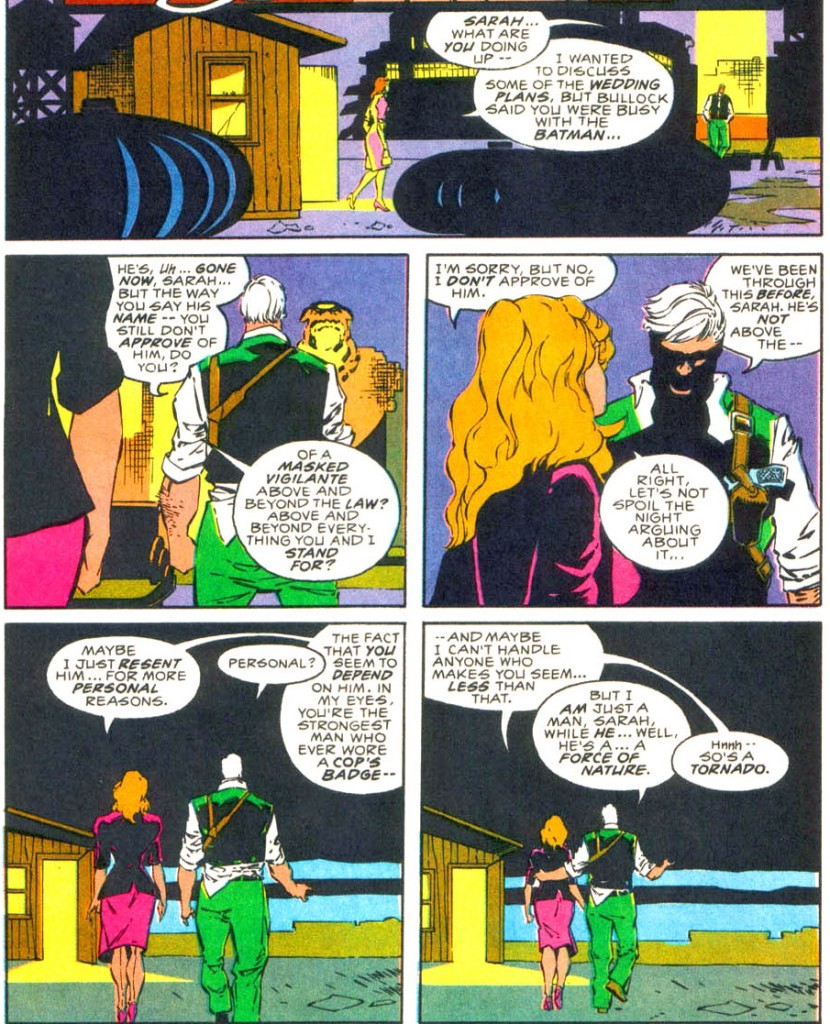 Batman #484
Batman #484
The scene above was written by Doug Moench, who initially used Sarah in a relatively ancillary way, with her views on Batman serving almost as a soap opera device, feeding into small character moments like this one. By contrast, Chuck Dixon tended to write Sarah Essen like a real cop, not just the Commissioner’s love interest… I particularly like her interactions with Jim in the thrilling arc ‘Electric City’ (Detective Comics #644-646).
Dennis O’Neil also gave Sarah some badass moments in 1992’s ‘Vows’ (Legends of the Dark Knight Annual #2), in which a simple trip to pick up her wedding dress soon escalated into a hardboiled crime adventure featuring blackmail, an electoral scandal, and a kidnapped child…
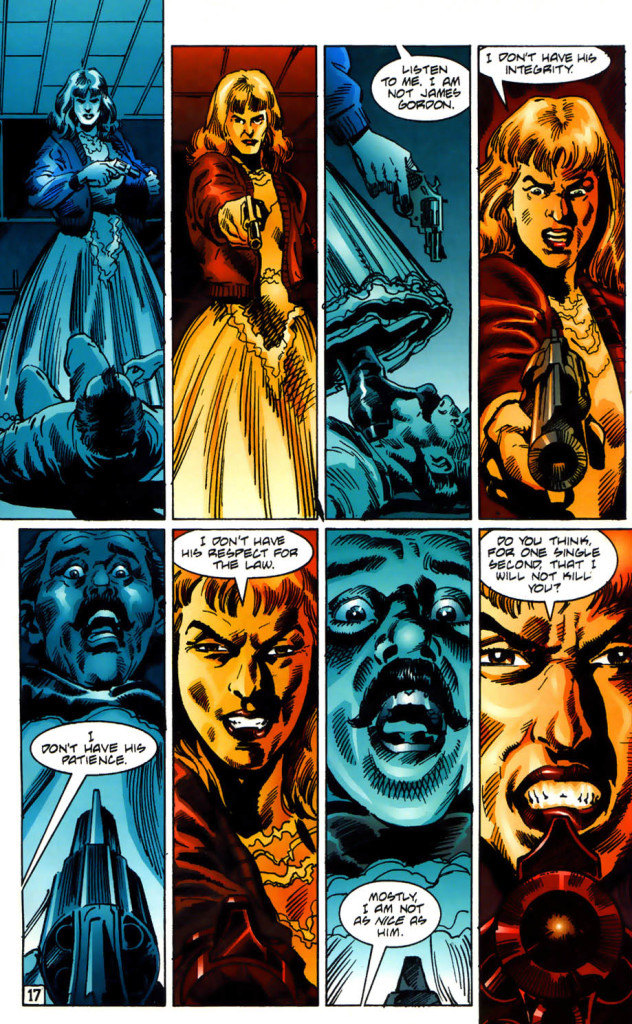 Legends of the Dark Knight Annual #2
Legends of the Dark Knight Annual #2
Sarah Essen and James Gordon ended up romantically getting married by a corrupt judge, on a boat, while waiting to be killed by gangsters, with a sadistic bent cop as a witness!
After this, their relationship continued to evolve in interesting directions. Following the Knightfall storyline – when Batman was temporarily replaced by the unstable AzBats – Commissioner Gordon found himself resenting the Dark Knight. Jim’s new attitude could have brought him closer to Sarah but, instead, she got fed up with her husband’s constant self-pity, which ironically lead to further marital strife…
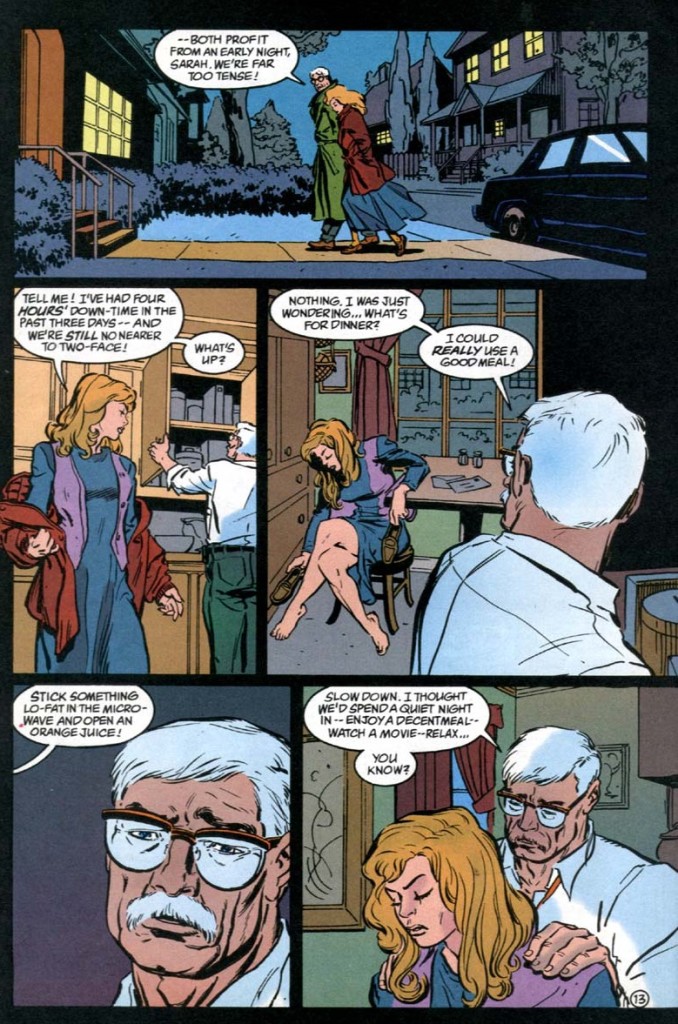
 Shadow of the Bat #33
Shadow of the Bat #33
The couple therefore switched sides on the whole Batman issue, with James losing faith in the caped hero and Sarah pragmatically accepting the city’s need for a Dark Knight. Because of this switch, in 1995 Mayor Armand Kroll – who had adopted a pro-Batman stance to go with his ‘law and order’ political platform – demoted Jim and promoted Sarah to Police Commissioner, a job she did for almost a full year.
The intricacies of the Gotham City Police Department are endlessly fascinating to me. Given that the city is full of quirky people, I imagine that even on a good day – when no major member of the rogues’ gallery is threatening to commit genocide – the police will probably have to cope with some smaller, lamer villain, like Death-Man (who keeps pretending to die every time he gets caught) or the Karate Creep (who practices martial arts on senior citizens). In the same way that the Hong Kong of Johnnie To’s Throw Down is a weird version of HK where everyone is into judo, Gotham is basically an alternate version of NYC where the average citizen is always on the verge of putting on a kooky suit and adopting a theme-based identity. Against this background, it’s amusing to see the police force run by a practical woman with little patience for costumed outlaws but taking it all in stride. Indeed, as commissioner, Sarah Essen Gordon played a significant role in several neat stories (including Chuck Dixon’s and Flint Henry’s Man-Bat mini-series).
Besides her ongoing marriage troubles, we saw Sarah struggle with the fact she was still a hands-on cop at heart and ultimately felt cooped up in her new position, shuffling paper instead of chasing criminals back on the street. Doug Moench effectively summed up this aspect in a little tale called ‘Commissions’ (Batman Chronicles #2), in which there was a hostage situation at the police headquarters…
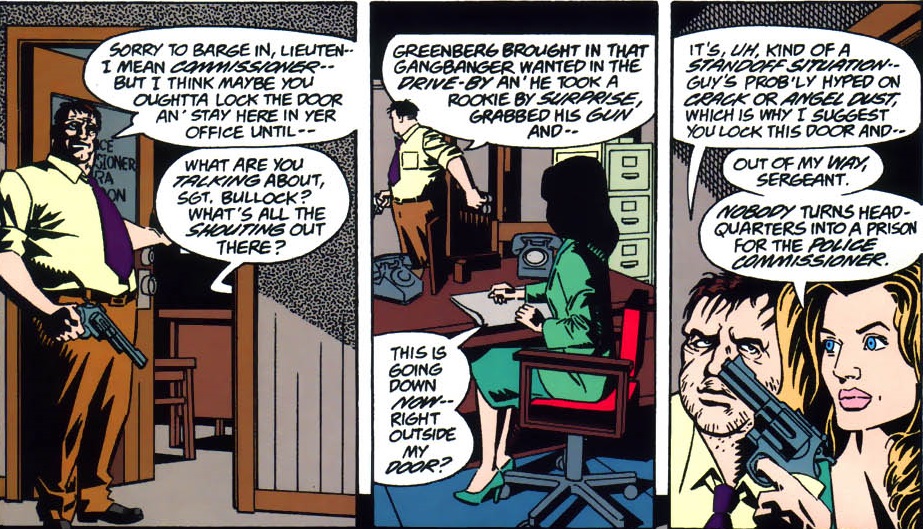 Batman Chronicles #2
Batman Chronicles #2
When the liberal Marion Grange replaced Armand Kroll as mayor, she acknowledged Sarah’s frustration. Grange gave her a new job as the mayor’s personal liaison to the Police Department and Sarah became more of a background character again (although Chuck Dixon did occasionally rescue her by providing Sarah with meatier supporting roles, for example in ‘The Death Lottery’ arc, from Detective Comics #708-710).
I suppose that, as a recognizable-yet-third-tier female cast member, Sarah Essen Gordon’s days were numbered. In 1998, Gotham was hit by an earthquake, which eventually lead to the No Man’s Land crossover, with the city abandoned by the federal government and mostly controlled by street gangs. Sarah stood by her husband and by the remaining police officers who fought to gradually reinstate some kind of formal order in the city. The story’s climax (cover-dated February 2000, written by Greg Rucka and Devin K. Grayson) involved Sarah going after the Joker – who had kidnapped dozens of babies over Christmas – and finally meeting her fate:
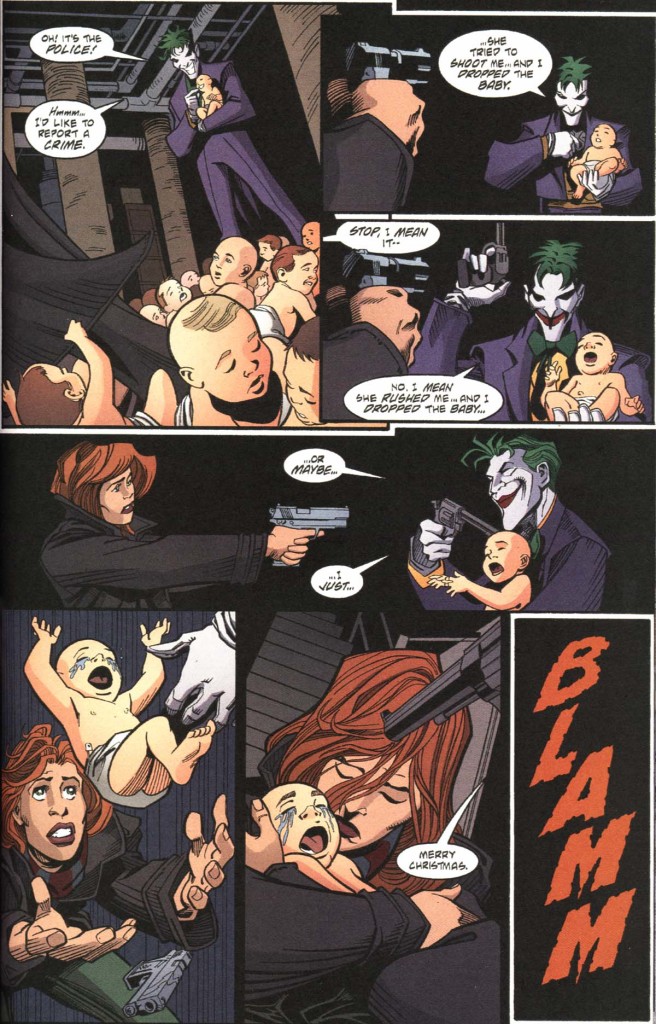 Detective Comics #741
Detective Comics #741
Having the Clown Prince of Crime kill Sarah Essen Gordon was a terrible move all around. I don’t know whether to blame the editors or the writers (Devin Grayson was actually one of the few prominent female writers of Batman comics and Greg Rucka went on to become a strong feminist voice in the medium), all I know is that we lost a character that could’ve still given us plenty of great stories…
And what was the point of this sacrifice? It did nothing for the Joker’s status, since the previous decades had already more than established that he was a dangerous psychopath, with a body count in the hundreds, who was able to permanently harm the regular cast (in the late ‘80s, he had crippled Barbara ‘Batgirl’ Gordon for life and beaten Robin to death). It also did very little for James Gordon’s overall characterization, since he already had hardcore personal reasons to hate the Joker (because of what happened to his daughter) and he remained unattached until 2011’s New 52 reboot, so it didn’t even open the way for a new relationship… Hell, Jim was already a widow anyway, so not even that was a new angle.
I’ve read that the writers initially considered killing off Detective Renee Montoya, which wouldn’t have been a good choice either (she had an engrossing arc later on). Looking back, if they really wanted to leave an impression by murdering a supporting member of the GCPD, they might as well have gone with Stan Kitch or perhaps Mackenzie Bock, who was quite active during No Man’s Land yet only made a few appearences afterwards anyway.
Still, I would’ve preferred if they’d found a different way of giving the story a lasting impact. The way in which subsequent comics showed Gotham trying to rebuild and regain some normality after a year of chaos made for a much more appealing read than seeing the various cast members at the funeral or all those downbeat moments with people mourning Sarah’s departure before moving on…
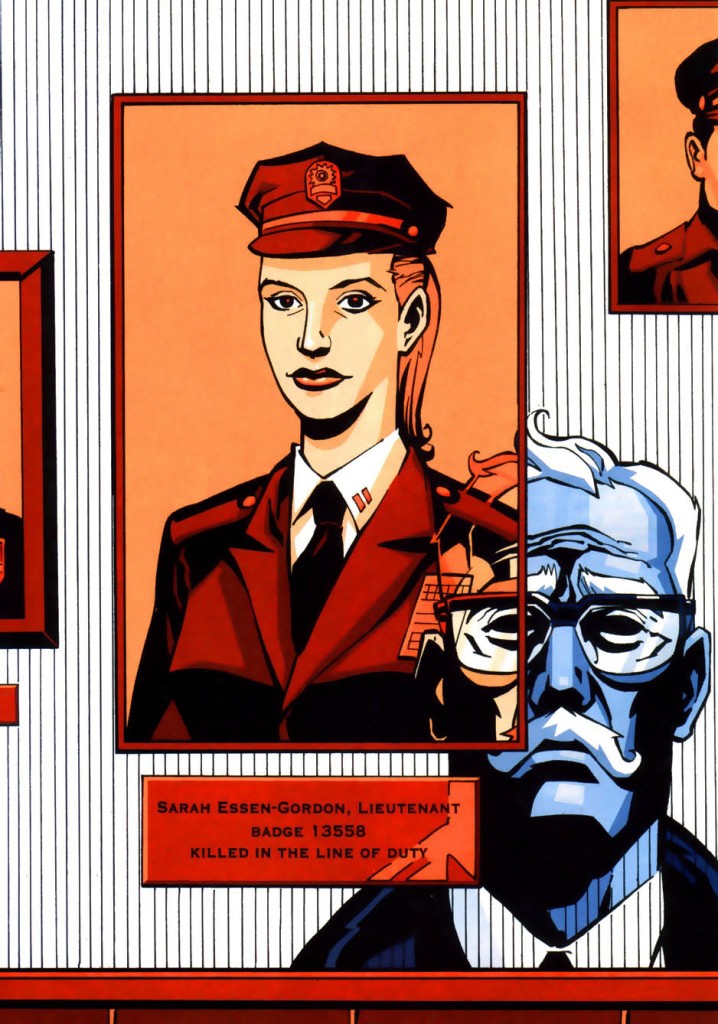 Detective Comics #742
Detective Comics #742
At the end of the day, what little long-term impact NML had on Gotham – such as a fierce rivalry between the citizens who had stayed and the ones who had fled – had nothing to do with Sarah’s death… If nothing else, at least Rucka and Grayson could’ve shown us something had changed as a specific result of that terrible moment, no matter how idiosyncratic: maybe clowns could become illegal, or there could be some kind of New Age cult worshipping Sarah Essen Gordon as the savior of Gotham’s infants.
I guess the creators felt bad about how they treated Sarah and that’s why, soon afterwards, they brought Maggie Sawyer into the Bat-books, as the head of the Major Crimes Unit. Apart from the fact that Maggie is a lesbian, you can easily imagine her earlier stories at the MCU starring Sarah Essen Gordon instead. It would’ve been more fun to see someone in that position who actually had a troubled backstory with the Caped Crusader (we got a little bit of that in Batman Beyond, which was set in a future where Barbara Gordon became police commissioner).
That said, I think there is hope. In this era bursting with multiple incarnations of comic book characters (in comics, film, television, etc), Sarah Essen Gordon is ripe for rediscovery. I heard she showed up in the Gotham TV show for a while, but that’s not enough… Recent adaptations of superhero franchises have increasingly resorted to race and gender flipping in order to bring some much-needed diversity to stories that – for historical reasons – used to attribute agency overwhelmingly to white males. Well, here is a well-defined female character who can easily replace James as the go-to depiction of Gotham’s Police Commissioner!
This wouldn’t feel too forced – after all, there is a precedent in the comics. Plus, it would actually create an interesting dynamic by giving us a police commissioner who both respects and distrusts Batman, who both resents having to resort to him and grudgingly accepts she has to (not to mention the sense of complicity rooted in their shared loyalty to Jim).
Until then, all we have is the tragic fulfillment of Sarah’s own unintended prophecy, back in 1993…
 Shadow of the Bat #9
Shadow of the Bat #9
NEXT: Crossover pitches.

Huh I had no idea that they used Sarah Essen outside of Year One. I really thought she was relegated to the Miller-verse.
And I didn’t know she got so lazily fridged. Her death didn’t even advance anyone’s character! What a waste